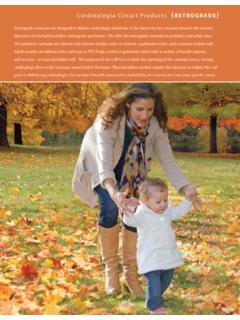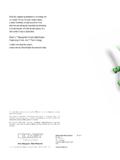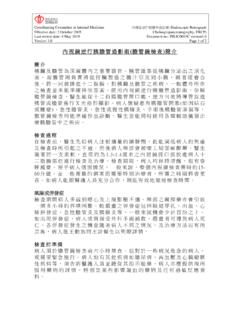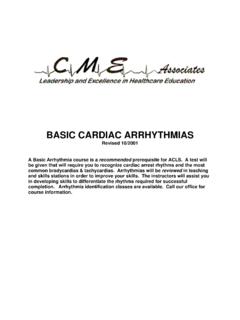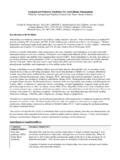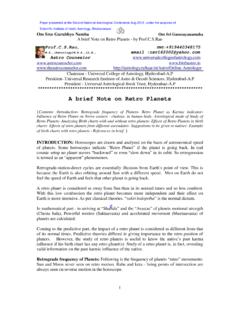Transcription of Armed Forces Pest Management Board Technical Guide No. 31
1 Armed Forces Pest Management Board Technical Guide No. 31 retrograde WASHDOWNS: Cleaning and Inspection Procedures Published and Distributed by the DEFENSE PEST Management INFORMATION ANALYSIS CENTER Forest Glen Section Walter Reed Army Medical Center Washington, DC 20307-5001 March 2008 Table of Contents ACKNOWLEDGMENTS DISCLAIMER FOREWORD INTRODUCTION o Purpose o Background Information o Current Information WASHDOWN LOCATION OPERATIONAL WASHDOWN EQUIPMENT INSPECTION AND CLEANING PROCEDURES o Inspectors o Administrative Requirements RESPONSIBILITIES SUMMARY REFERENCES APPENDICES o APPENDIX A - Criteria for Selecting and Equipping a Washdown Location o APPENDIX B - Operational Washdown Equipment o APPENDIX C - Guide for Operational Washdowns With Illustrations o APPENDIX D - Flow Chart of Typical Operational Washdown o APPENDIX E - Sample Vehicle Tag (White or Manila Tag) o APPENDIX F - Sample Inspection Log Book Entry o APPENDIX G - Sample letter Format to USDA Officials o APPENDIX H - Addresses of Customs and Border Protection, United States Department of Agriculture-APHIS and Department of Defense Offices Responsible for Clearance Authorization o APPENDIX I - Land Snails o APPENDIX J - USDA APHIS History of Interceptions ACKNOWLEDGMENTS Special thanks to the AFPMB Quarantine/Stored Commodities Protection Committee and the following personnel/organizations who provided input and review: LCDR Eric Hoffman, MSC, USN, Navy Disease Vector Ecology and Control Center, Jacksonville, FL, LtCol John Stein, AMSA, Washington, DC; Mr.
2 Al Bane, United States Transportation Command, Scott AFB, IL; Ms. Candace Funk, USDA APHIS PPQ, Washington, DC, Ms. Susan Kostelecky, USDA APHIS PPQ, Mr. Gary Walker, Defense Supply Center Philadelphia, Dr. Pete Egan, Armed Forces Pest Management Board , Washington, DC and the Navy Disease Vector Ecology and Control Center, Bangor, Washington. DISCLAIMER Any mention of specific proprietary products regarding washing equipment or safety items does not constitute a recommendation or an endorsement of these products by the Department of Defense. Neither should the absence of an item necessarily be interpreted as DoD disapproval. The material presented in this Technical Guide (TG) are guidelines. Information or inquiries concerning any equipment or safety items should be sent through Command Pest Management Professionals or Applied Biologists to the Armed Forces Pest Management Board Quarantine Committee for evaluation. FOREWORD This Technical Guide (TG) is not a regulation or instruction.
3 Rather, it describes procedures, outlines responsibilities and defines requirements for conducting retrograde washdowns to satisfy agricultural and public health pest exclusion requirements for re-deploying ships, aircraft, and equipment from OCONUS (outside the continental United States) locations. Other cleaning methods (compress air cleaning and mechanical removal-sweeping) may be appropriate given the sensitivity of equipment or feasibility of using water. This document will be periodically reviewed and updated to insure that information contained herein reflects current procedures, rules and regulations. 2 Individuals using this TG are encouraged to submit comments and suggestions for improvement. Comments should be directed to the Executive Director, Armed Forces Pest Management Board , Walter Reed Army Medical Center, Forest Glen Section, Washington, DC 20307-5001; (301) 295-7476; FAX (301) 295-5045. INTRODUCTION retrograde washdowns are performed to safeguard United States agriculture and natural resources from risks associated with the entry, establishment, or spread of animal/plant pests and noxious weeds.
4 This Technical Guide (TG) provides information on cleaning techniques and inspection procedures currently used by Department of Defense (DoD) personnel responsible for washing and reviewing equipment, supplies and vehicles. Background Information Over the past 200 years, several thousand foreign plant and animal species have become established in the United States. About one in seven has become invasive, leading to problems that, according to figures provided by Cornell University, cost the United States more than $138 billion each year. An invasive species is an alien species whose introduction does or is likely to cause economic or environmental harm or harm to human health. Invasive plants, animals, and aquatic organisms often reduce the economic productivity and ecological integrity of agriculture and natural resources. The most common vertebrate invasive species in the continental United States include nutria, house sparrows, European starlings, and commensal rodents (roof rat, Norway rat, and house mouse).
5 Additionally, numerous invertebrate invasive species have also become established in the United States. Examples include zebra mussels, imported fire ants, Africanized honey bees, and many other insects. In Hawaii and some mainland States, feral pigs, goats, and cats have severely impacted natural and environmental resources. Feral animals are domesticated animals that have escaped and become wild, including their offspring born in the wild. Effects of Invasive Species Many invasive species clearly impair biological diversity by causing population declines, species extinctions, shifts in predator/prey dynamics, shifts in species niches, changes in habitat, and reductions in ecosystem complexity. The very establishment of a harmful invasive species diminishes biological diversity because, as certain species disperse to more places, the originating and invaded areas become more alike biologically. In 1993, Congress' Office of Technology Assessment reported that devastating invasions of plants, insects, aquatic invertebrates, pathogens, and other organisms have changed ecosystems and permanently diminished the biological diversity associated with them.
6 Examples of these in the United States include: melaleuca (a wetlands tree), gypsy moth, 3spruce bark beetle, zebra mussel, larch canker, chestnut blight, and pinewood nematodes. Fear of the incursion of other harmful invasive species, such as the brown tree snake, is increasing. Conservation experts have found that in the United States, invasive alien plant infestations cover 100 million acres and are spreading at a rate of 14 percent per year, an area twice the size of Delaware. Recent studies have also revealed that San Francisco Bay is invaded by a new exotic species on the average of once every 12 weeks. Movement Naturally occurring movement of species into the United States is uncommon. Most invasive species arrive in association with human activities or transport. Species can be brought into the country and released intentionally, or their movement and release can be an unintentional byproduct of cultivation, commerce, tourism, or travel. Many species enter the United States each year as contaminants of commodities.
7 Agricultural produce, nursery stock, cut flowers, and timber can harbor insects, plants pathogens, slugs, and snails. Weeds continue to enter the United States as seed contaminants. Plant pathogens sometimes arrive as unintended contaminants of plant materials. Fish and shrimp pathogens and parasites have been introduced into the United States on infected stock for aquaculture. Crates and containers can harbor snails, slugs, mollusks, beetles, and microorganisms. Military cargo transport also brings in harmful species, such as the Asian gypsy moth and brown tree snakes. Ballast water that is released from ships as cargo is loaded or unloaded has brought in several destructive aquatic species. Safeguarding the United States from Invasive Species Executive Order 13112 enhances and orders coordination of Federal activities to control and minimize the economic, ecological, and human health impacts caused by invasive species. The Executive order also established a National Invasive Species Council to oversee a Management plan detailing the goals and objectives of the efforts of the involved Federal agencies.
8 This Executive order provides new impetus and importance to the basic work performed by the Department of Agriculture's (USDA) Animal and Plant Health Inspection Service (APHIS) to prevent pests and diseases that threaten our biological resources from being introduced and becoming established in the United States. Both ecosystems and the individual species within them are vulnerable to invasive pests and pathogens. In protecting the United States from harmful invasive species, APHIS is responsible for excluding and managing invasive species that can potentially affect plant and animal health, either directly or indirectly. Through its activities, APHIS protects not only agriculture but also forest, rangeland, and wetland ecosystems. APHIS works closely with USDA's Forest Service and the Department of the Interior's Bureau of 4 Land Management , National Park Service, Fish and Wildlife Service and the Department of Defense. APHIS controls certain types of invasive species and vertebrate pests that affect native ecosystems, rather than agricultural resources.
9 Certain specific activities focus on protecting and managing endangered species as well as migratory bird populations. The first and most effective means of protection is through exclusion or prevention of intentional or unintentional entry of harmful invasive species. A second strategy uses tactics including detecting, eradicating, managing, or controlling specific pests that have become established. Third, certain endangered species need special protection against a host of attackers. Invasive species can be a threat to indigenous endangered species. Military Importance: Clearly, the potential importation of invasive species, such as snakes, insects, snails, and various crustaceans on military vehicles and equipment that are present in most of the world-wide areas frequented by the DoD is a primary concern of the USDA. DoD personnel are often required to re-deploy from anywhere in the world. Associated with this movement is an elevated risk for the inadvertent introduction of exotic plant and animal pests into the United States.
10 Due to the characteristics of exotic pests, irreparable damage to human health, agriculture, forestry, or the environment may result. Plant debris, garbage, food, soil, and even fresh water from foreign countries may contain organisms of quarantine importance. Pathogens, insects, nematodes and a variety of other animals may be carried in such media. These organisms, if allowed to enter the United States, could proliferate to catastrophic proportions, unhindered by natural enemies. Because of this risk, it is DoD policy that all organizations and personnel involved in the movement of DoD sponsored cargo, personal property and accompanied baggage will take all steps necessary to prevent the spread of exotic pests from one location to another. As a means to standardize, regulations and procedures pertaining to military retrograde cargo washdowns were outlined in DoD Instruction (Processing and Shipping DoD Sponsored retrograde Material Destined for Shipment to the United States, its Territories, Trusts and Possessions) initially during the Viet Nam war era.
